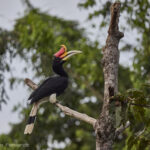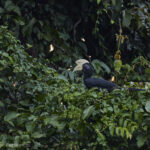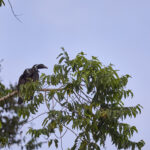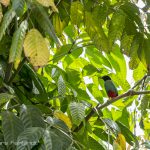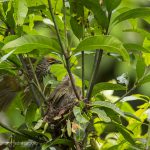Rhinoceros hornbill – Buceros rhinoceros Linnaeus, 1758 (B. r. borneoensis Schlegel & Müller, S, 1845) – of Borneo (300m ASL)
Buceros rhinoceros Linnaeus 1758, the rhinoceros hornbill, is a large canopy dwelling hornbill of the Sundaic region where it inhabits mature evergreen forest from southern Thailand through Peninsular Malaysia Sumatra Java and Borneo, with the species now considered locally extinct in Singapore. Three subspecies are generally recognized that align closely with geography, B. r. rhinoceros in the southern Malay Peninsula and Sumatra, B. r. borneoensis in Borneo, and B. r. silvestris in Java. Adults show mostly black plumage with a white vent and a long white tail crossed by a broad black band, and both sexes carry the species signature upcurved casque above the heavy bill. The bare bill and casque start out whitish and are progressively stained orange to red by secretions from the uropygial gland transferred during preening, while a simple sex difference often noted in the field is a reddish to orange iris in males and a paler bluish white iris in females. The casque is hollow and, in this species, strongly upturned; experimental and comparative work together with field accounts indicate it can act as a resonance chamber that enhances loud calls, although multiple functions are possible across hornbills. The species is largely frugivorous and relies heavily on figs but also takes a range of invertebrates and small vertebrates, and it is widely regarded as an important seed disperser in Asian lowland forests. Pairs are socially monogamous and typically nest once per year in natural tree cavities; the female enters the cavity and the pair seals the entrance with a wall of material leaving only a narrow slit through which the male provisions her and the chicks. Clutches usually comprise one to two eggs with an incubation period of about thirty seven to forty six days, the female remaining enclosed for several additional weeks and fledging occurring at roughly four months after hatching. Habitat loss through the removal of large cavity bearing trees together with hunting and some trapping pressure contribute to ongoing declines, and the species is currently assessed as Vulnerable on the IUCN Red List. The generic name Buceros derives from classical Greek with bous meaning ox and keras meaning horn, a reference to the prominent casque, while the specific epithet rhinoceros comes from Greek rhinos meaning nose and keras meaning horn, alluding to the distinctive horn like structure on the bill.
